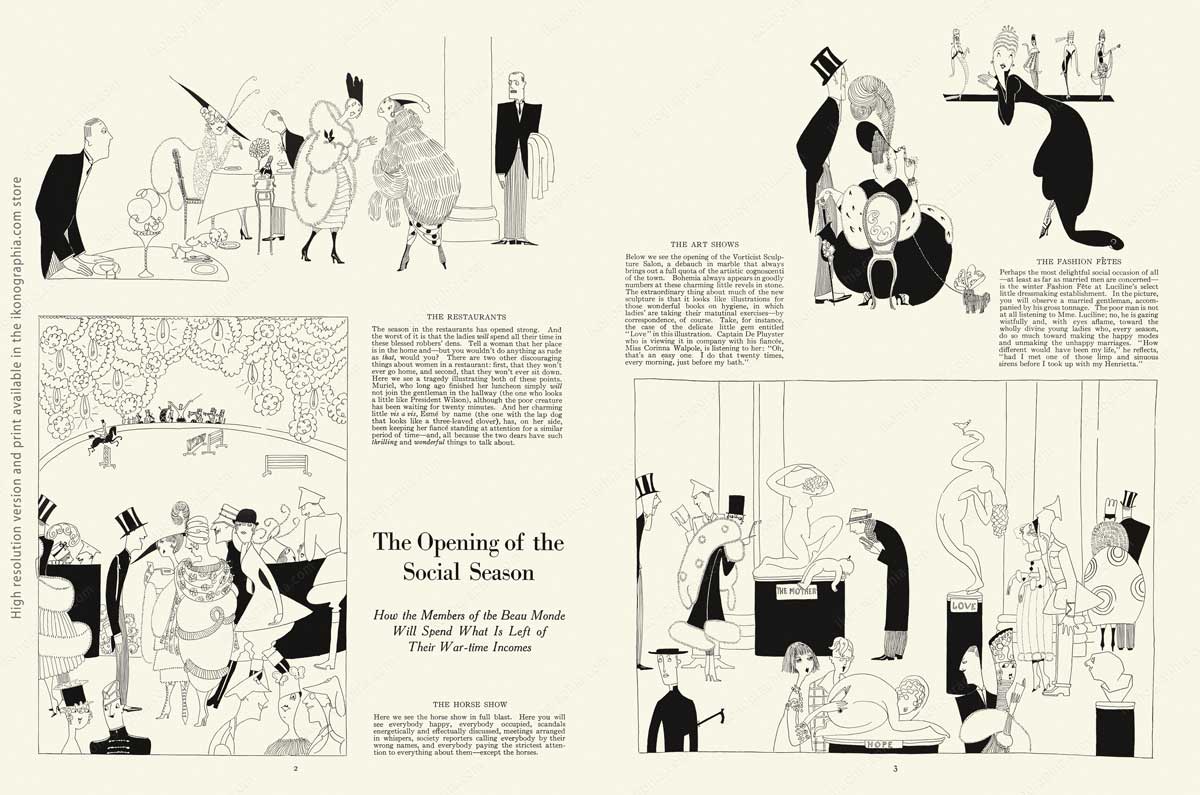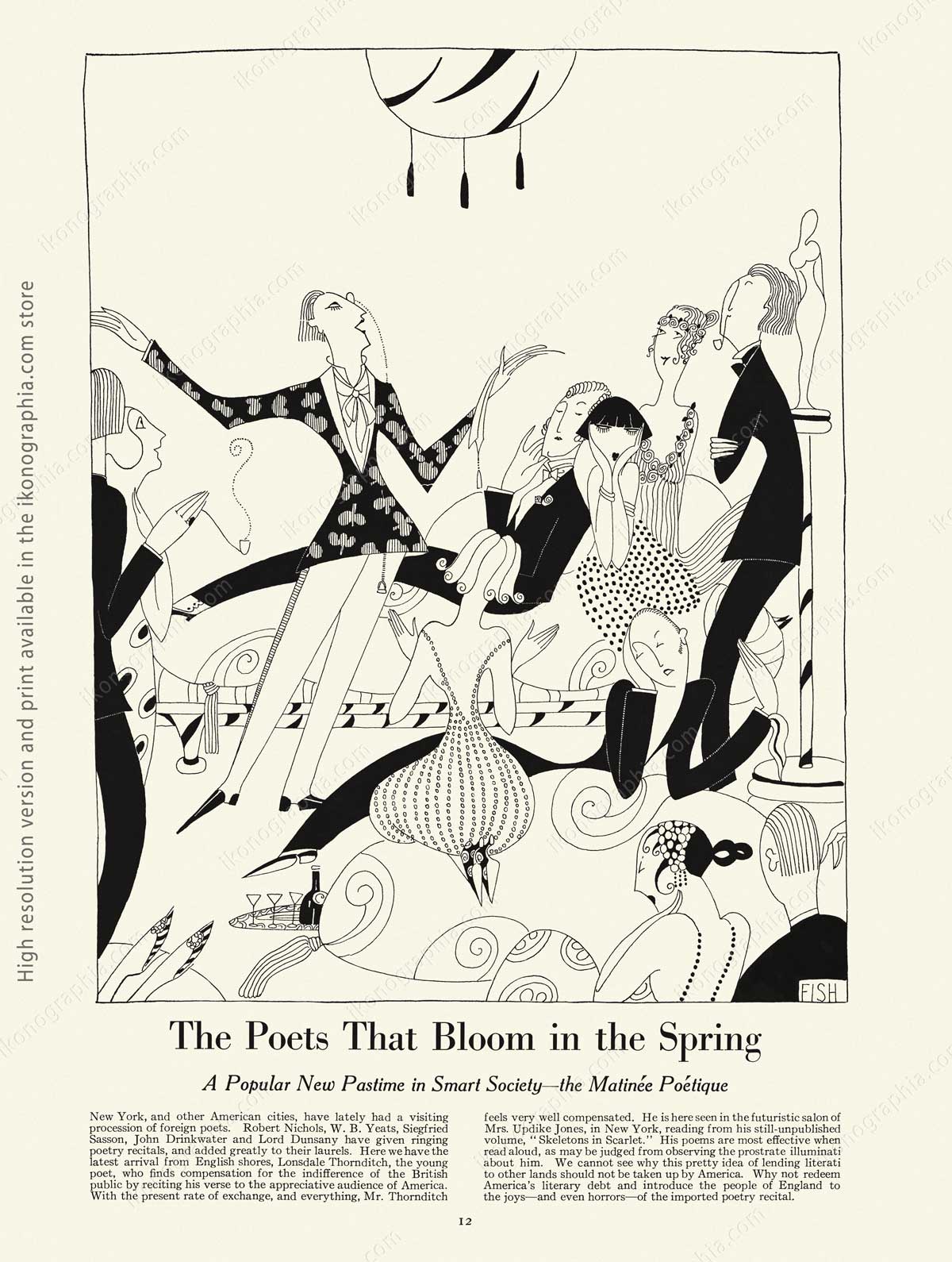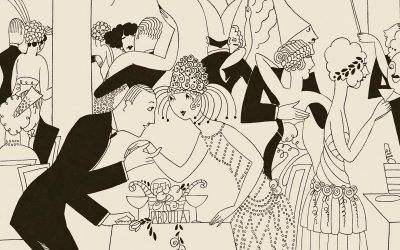American 1920s High Society’s lifestyles, as seen by Anne Fish
The original cover by Anne Fish of the book “High Society. Hints on how to Attain, Relish – and Survive It. A Pictorial Guide to Life in our Upper Circles.”
In December 1920, G.P. Putnam’s Sons published “High Society,” a unique book celebrating the work of the star-illustrator Anne Fish. It’s a selection of drawings published on Vanity Fair US from 1914 to 1920.
The book provides a unique, rich lens into American and international high society’s lifestyles.
We’ll use the original presentation and book texts written by Dorothy Parker.
High Society. Hints on how to Attain, Relish – and Survive It.
A Pictorial Guide to Life in our Upper Circles.
High Society is a new collection of Fish’s remarkable drawings of life in our upper circles. In fact, it is a complete pictorial guide to the ways and habits of these strange beings who dwell in the thick, sweet atmosphere of adulation and the rich, regrant redolence of wealth.
Dowagers, divorcées and débutantes, bridge friends, trick butlers, tango addicts, amateur vampires—the fortunate reader meets them all in this book. And sees them with the amused, satirical eye, and through the clever intelligence, of one of the most distinguished of living black and white illustrators.
There is beauty in Fish’s extraordinary gallery as well as satire. The patterns of the flapper’s frocks are like laces and hangings by Beardsley. A Pomeranian on the rug becomes a patch of elegant scroller like something in a Japanese print. Even her profiteering millionaires become designs made up of deft and satisfying curves.
The Opening of the Social Season. How the Members of the Beau Monde Will Spend What Is left of Their War-time Incomes. First double page of the book. Originally published in Vanity Fair, November 1917.
FULL PAGES TEXT
The Opening of the Social Season.
How the Members of the Beau Monde Will Spend What Is Left of Their War-Time Income.
THE RESTAURANTS.
The season in the restaurants has opened strong. And the worst of it is that the ladies will spend all their time in these blessed robbers’ dens. Tell a woman that her place is in the home and — but you wouldn’t do anything as rude as that, would you? There are two other discouraging things about women in a restaurant: first, that they won’t ever go home, and second, that they won’t ever sit down. Here we see a tragedy illustrating both of these points. Muriel, who long ago finished her luncheon simply will not join the gentleman in the hallway (the one who looks a little like President Wilson), although the poor creature has been waiting for twenty minutes. And her charming little vis a vis, Esme by name (the one with the lap dog that looks like a three-leaved clover), has, on her side, been keeping her fiance standing at attention for a similar period of time — and, all because the two dears have such thrilling and wonderful things to talk about.
THE HORSE SHOW.
Here we see the horse show in full blast. Here you will see everybody happy, everybody occupied, scandals energetically and effectually discussed, meetings arranged in whispers, society reporters calling everybody by their wrong names, and everybody paying the strictest attention to everything about them — except the horses.
THE ART SHOWS.
Below we see the opening of the Vorticist Sculpture Salon, a debauch in marble that always brings out a full quota of the artistic cognoscenti of the town. Bohemia always appears in goodly numbers at these charming little revels in stone. The extraordinary thing about much of the new sculpture is that it looks like illustrations for those wonderful books on hygiene, in which ladies’ are taking their matutinal exercises—by correspondence, of course. Take, for instance, the case of the delicate little gem entitled “Love” in this illustration. Captain De Pluyster who is viewing it in company with his fiancée, Miss Corinna Walpole, is listening to her: “Oh, that’s an easy one. I do that twenty times, every morning, just before my bath.”
THE FASHION FÊTES:
Perhaps the most delightful social occasion of all — at least as far as married men are concerned — is the winter Fashion Fete at Luciline’s select little dressmaking establishment. In the picture, you will observe a married gentleman, accompanied by his gross tonnage. The poor man is not at all listening to Mme. Luciline; no, he is gazing wistfully and, with eyes aflame, toward the wholly divine young ladies who, every season, do so much toward making the happy modes and unmaking the unhappy marriages. “How different would have been my life,” he reflects, “had I met one of those limp and sinuous sirens before I took up with my Henrietta.”
“High Society” is the smartest book of the season. It contains 156 of Miss Fish’s inimitable drawings and their entertaining captions; is attractively bound and beautifully printed.
“High Society” is published by G.P. Putnam’s Sons and is on sale at all better class book stores. Or-fill out the coupon below and mail it with your cheque to us for one of the first copies off the press. Price $5.30, postpaid.
Everybody Who IS Anybody is going to MAIL THIS COUPON.
Above is the original text from Vanity Fair’s advertisement for the book launch.
The cover is in color and, although beautiful, is unrelated to the book’s drawing, all in black and white with a different style. This illustration was initially used for the cover of Vanity Fair for April 1920.
In that years, Anne Fish was the magazine’s star artist getting a reputation from her inimitable black and white sketches. Still, all the 33 covers she drew for Vanity Fair are in color.
STOP!
No reader will be permitted to pass beyond this page who is not actually in society. This book is not for those who dwell in the gloom of mere respectability, or the blaze of sheer wealth. It is a pasturage intended solely for those who bask in the sunlight of the smartest society.
Those whose social standing could conceivably be classed with that of brewers, green-grocers, minor poets, munition magnates, linen drapers, provincial actors, and cubist sculptors, must not trespass within these covers.
BUT
If your name appears in all the Social Directories; if you are a member of six or eight fashionable clubs; if you never plan a dinner without unpotting a pound or so of pâté de foie gras; if you never witness an opera except from an opera box ; if you never go to the city except in an imported motor-car, why then just knock at the title page, open the door, walk in, take off your monocle — or your turreted tiara — and make yourself perfectly at home.
The Poets That Bloom in the Spring. A striking illustration from “High Society.” Artwork by Anne Fish.
Fish, introduced by Vanity Fair’s Editor Heyworth Campbell.
“When, in the summer of 1914, certain remarkable drawings of social life, by a new hand, began to appear, in Vanity Fair in New York, and in The Tatler in London, people all over the world stared at them, amazed, amused, admiring. Then they stared at each other, demanding, with one voice: “Who, under the sun, is Fish?” Meantime, a tall, slender young girl of twenty-two was drawing the pictures that were helping to keep laughter alive during those dark days — and troubling very little indeed as to whether Fame’s wandering searchlight would ever find her out.
That girl was “Fish,” deemed to-day, by many critics, the most distinguished of satirical black-and-white illustrators. Miss Fish has created, on that miraculous drawing-board of hers, a complete human society, as original and amusing as the worlds of George Du Maurier and Charles Dana Gibson. It is a world populated by young-old matrons, astoundingly mature young girls, Victorian lady remnants, resplendent captains of industry, pussy-footing English butlers, amourous nursemaids, race touts, yearning young lovers, swanking soldiers, blank and vapid bores, bridge-playing parsons, and middle-class millionaires. But, for all its sophistication, it is a world of innocence.
The creatures in it are of a touching simplicity, an incredible naïveté. Fish is one of the only caricaturists who has ever done this sort of satire without malice — who has ever treated the poor, misguided children of this world as if they were really children. But there is beauty in her extraordinary gallery, as well as caricature. The patterns on her flappers’ gowns are like laces and hangings by Beardsley; a Pomeranian lying on a rug, becomes a patch of elegant scrollery, like a detail in a Japanese print.
There is no trace at all, in her drawings, of the hackneyed conventions of illustration : everything in them is presented through the medium of an original feeling for form. Even her profiteering millionaires become designs made up of deft and satisfying curves.
Her sketches are creations not only of a clever and sophisticated intelligence, but of a true artist. In depicting fashionable society Miss Fish is perhaps at her best, for the reason that the spectacle which seems to interest her most is that pageant of “smart” types that race, as if by magic, to her drawing-board, from every haunt of social life — from opera boxes, ballrooms, race-meets, cabarets, smart supper parties, dinners of state, musicales, and the thousand and one happy backgrounds against which the contemporary beau monde is wont to pose and posture. In the pages of this book the reader will meet only with Miss Fish’s social creations: the double-decked dowagers, the amateur vampires, the horsey horsemen, the diabolically clever little debutantes, the tango addicts, the incurable bridge-players, the worn-out week-end hostesses, and the myriad types of human beings that seem perpetually to haunt the portals of our most exalted society.
For six years, Miss Fish’s sketches have appeared, in America, only in Vanity Fair. For the past two years the British public has only seen her work in Vogue (the British edition), and in The Patrician, — the English edition of Vanity Fair. All the drawings in this book appear here with the permission of Conde Nast, the publisher of Vogue, Vanity Fair, and The Patrician. The Editor: Heyworth Campbell”.
“The Committee of Welcome”. Detail from “A Week-End With the Recently Rich”
High Society 1920s Stories. Index
PUBLISHED:
American 1920s High Society’s lifestyles, as seen by Anne Fish
Flirting, Engagement, Wedding & Divorce in High Society.
High Society's Social Events.
COMING SOON:
1920s High Society & Art.
1920s High Society's Weekends.
1920s High Society. Life Behind Aristocratic Doors.
1920s High Society. Sports and Leisure.
1910s High Society and World War I
Browse all "Anne Fish" Stories
Social Events in 1920s High Society. By Fish
A second compilation of pages from Vanity Fair and the book “High Society” on “Social Events in 1920s High Society,” illustrated by Anne Fish.
Any double-page plate focuses on a specific topic providing a unique, rich lens into American and international high society’s lifestyles of the 1910s and 1920s. Rigorously in black and white, these inimitable sketches are completed with entertaining captions.
Flirting, Engagement, Weddings & Divorce in 1920s High Society. By Fish
A first compilation of pages from Vanity Fair and the book “High Society” on Flirting, Engagement, Weddings & Divorce, illustrated by Anne Fish.
Any double-page plate focuses on a specific topic providing a unique, rich lens into American and international high society’s lifestyles of the 1910s and 1920s. Rigorously in black and white, these inimitable sketches are completed with entertaining captions.
Abdulla Cigarettes 1921. Mélisande at Montecarlo, by Anne Fish
The full 1921 Abdulla ad campaign in the French magazine “La Vie Parisienne.” The star is Mélisande, a wealthy, young, elegant, and beautiful Parisian who goes to Monte Carlo to try her luck at the casino. Here she meets an elegant Englishman who woos her and with whom she gets engaged and finally marries three days before New Year’s Eve; her life unfolds between suitors, losses, and wins at the table and a lifestyle of unbridled luxury.
About Anne Fish.

Annie Harriet Fish Sefton (1890-1964) was a British cartoonist and illustrator. She is best known as "Fish," her maiden name, and how she signed her works.
In England, from 1914 to 1919, she illustrated for "The Tatler" a famous column, "The Letters of Eve."
From 1914 to 1932, she drew hundreds of striking cartoons for Vanity Fair, Harper's Bazaar, and Cosmopolitan in the US, showcasing her versatility and adaptability as an artist.
From 1919 to 1932, she drew eleven campaigns for Abdulla, published in French on "La Vie Parisienne" and in English on "Punch," "The Sketch," and "The Sphere."
Her books include High Society (1920), The Eve Book (1920), and Rubaiyat of Omar Khayyam (1922).












